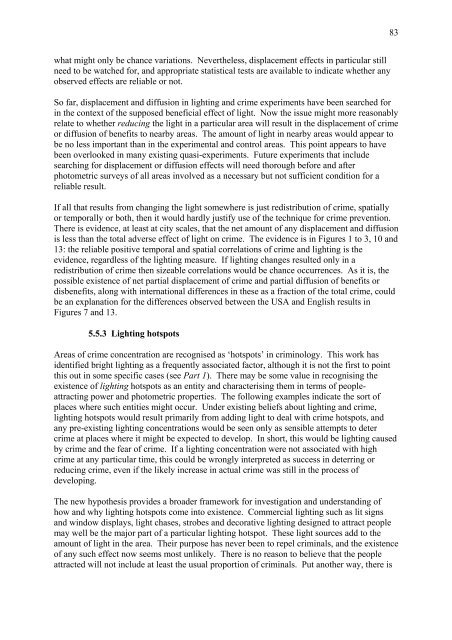Outdoor Lighting and Crime - Amper
Outdoor Lighting and Crime - Amper
Outdoor Lighting and Crime - Amper
You also want an ePaper? Increase the reach of your titles
YUMPU automatically turns print PDFs into web optimized ePapers that Google loves.
what might only be chance variations. Nevertheless, displacement effects in particular still<br />
need to be watched for, <strong>and</strong> appropriate statistical tests are available to indicate whether any<br />
observed effects are reliable or not.<br />
So far, displacement <strong>and</strong> diffusion in lighting <strong>and</strong> crime experiments have been searched for<br />
in the context of the supposed beneficial effect of light. Now the issue might more reasonably<br />
relate to whether reducing the light in a particular area will result in the displacement of crime<br />
or diffusion of benefits to nearby areas. The amount of light in nearby areas would appear to<br />
be no less important than in the experimental <strong>and</strong> control areas. This point appears to have<br />
been overlooked in many existing quasi-experiments. Future experiments that include<br />
searching for displacement or diffusion effects will need thorough before <strong>and</strong> after<br />
photometric surveys of all areas involved as a necessary but not sufficient condition for a<br />
reliable result.<br />
If all that results from changing the light somewhere is just redistribution of crime, spatially<br />
or temporally or both, then it would hardly justify use of the technique for crime prevention.<br />
There is evidence, at least at city scales, that the net amount of any displacement <strong>and</strong> diffusion<br />
is less than the total adverse effect of light on crime. The evidence is in Figures 1 to 3, 10 <strong>and</strong><br />
13: the reliable positive temporal <strong>and</strong> spatial correlations of crime <strong>and</strong> lighting is the<br />
evidence, regardless of the lighting measure. If lighting changes resulted only in a<br />
redistribution of crime then sizeable correlations would be chance occurrences. As it is, the<br />
possible existence of net partial displacement of crime <strong>and</strong> partial diffusion of benefits or<br />
disbenefits, along with international differences in these as a fraction of the total crime, could<br />
be an explanation for the differences observed between the USA <strong>and</strong> English results in<br />
Figures 7 <strong>and</strong> 13.<br />
5.5.3 <strong>Lighting</strong> hotspots<br />
Areas of crime concentration are recognised as ‘hotspots’ in criminology. This work has<br />
identified bright lighting as a frequently associated factor, although it is not the first to point<br />
this out in some specific cases (see Part 1). There may be some value in recognising the<br />
existence of lighting hotspots as an entity <strong>and</strong> characterising them in terms of peopleattracting<br />
power <strong>and</strong> photometric properties. The following examples indicate the sort of<br />
places where such entities might occur. Under existing beliefs about lighting <strong>and</strong> crime,<br />
lighting hotspots would result primarily from adding light to deal with crime hotspots, <strong>and</strong><br />
any pre-existing lighting concentrations would be seen only as sensible attempts to deter<br />
crime at places where it might be expected to develop. In short, this would be lighting caused<br />
by crime <strong>and</strong> the fear of crime. If a lighting concentration were not associated with high<br />
crime at any particular time, this could be wrongly interpreted as success in deterring or<br />
reducing crime, even if the likely increase in actual crime was still in the process of<br />
developing.<br />
The new hypothesis provides a broader framework for investigation <strong>and</strong> underst<strong>and</strong>ing of<br />
how <strong>and</strong> why lighting hotspots come into existence. Commercial lighting such as lit signs<br />
<strong>and</strong> window displays, light chases, strobes <strong>and</strong> decorative lighting designed to attract people<br />
may well be the major part of a particular lighting hotspot. These light sources add to the<br />
amount of light in the area. Their purpose has never been to repel criminals, <strong>and</strong> the existence<br />
of any such effect now seems most unlikely. There is no reason to believe that the people<br />
attracted will not include at least the usual proportion of criminals. Put another way, there is<br />
83
















